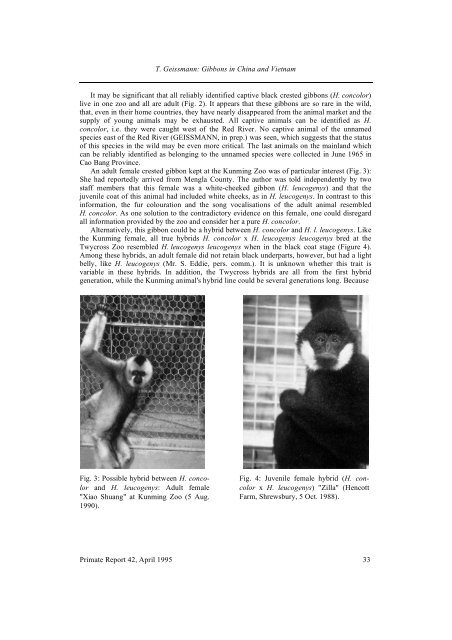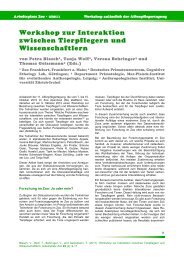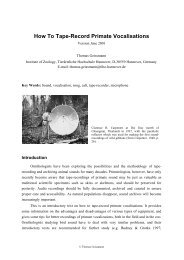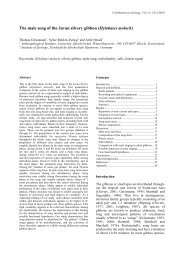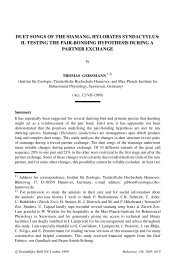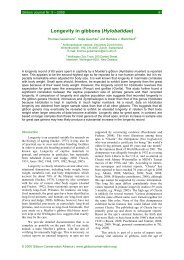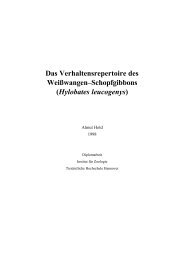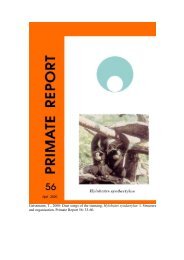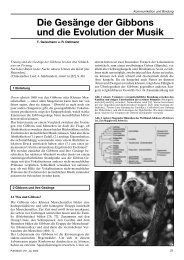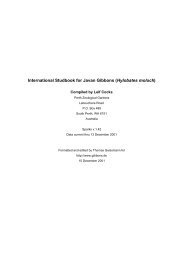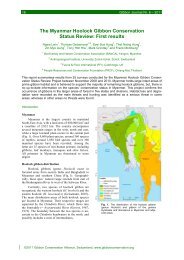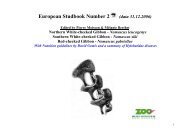captive management and conservation of gibbons in china and ...
captive management and conservation of gibbons in china and ...
captive management and conservation of gibbons in china and ...
Create successful ePaper yourself
Turn your PDF publications into a flip-book with our unique Google optimized e-Paper software.
T. Geissmann: Gibbons <strong>in</strong> Ch<strong>in</strong>a <strong>and</strong> VietnamIt may be significant that all reliably identified <strong>captive</strong> black crested <strong>gibbons</strong> (H. concolor)live <strong>in</strong> one zoo <strong>and</strong> all are adult (Fig. 2). It appears that these <strong>gibbons</strong> are so rare <strong>in</strong> the wild,that, even <strong>in</strong> their home countries, they have nearly disappeared from the animal market <strong>and</strong> thesupply <strong>of</strong> young animals may be exhausted. All <strong>captive</strong> animals can be identified as H.concolor, i.e. they were caught west <strong>of</strong> the Red River. No <strong>captive</strong> animal <strong>of</strong> the unnamedspecies east <strong>of</strong> the Red River (GEISSMANN, <strong>in</strong> prep.) was seen, which suggests that the status<strong>of</strong> this species <strong>in</strong> the wild may be even more critical. The last animals on the ma<strong>in</strong>l<strong>and</strong> whichcan be reliably identified as belong<strong>in</strong>g to the unnamed species were collected <strong>in</strong> June 1965 <strong>in</strong>Cao Bang Prov<strong>in</strong>ce.An adult female crested gibbon kept at the Kunm<strong>in</strong>g Zoo was <strong>of</strong> particular <strong>in</strong>terest (Fig. 3):She had reportedly arrived from Mengla County. The author was told <strong>in</strong>dependently by twostaff members that this female was a white-cheeked gibbon (H. leucogenys) <strong>and</strong> that thejuvenile coat <strong>of</strong> this animal had <strong>in</strong>cluded white cheeks, as <strong>in</strong> H. leucogenys. In contrast to this<strong>in</strong>formation, the fur colouration <strong>and</strong> the song vocalisations <strong>of</strong> the adult animal resembledH. concolor. As one solution to the contradictory evidence on this female, one could disregardall <strong>in</strong>formation provided by the zoo <strong>and</strong> consider her a pure H. concolor.Alternatively, this gibbon could be a hybrid between H. concolor <strong>and</strong> H. l. leucogenys. Likethe Kunm<strong>in</strong>g female, all true hybrids H. concolor x H. leucogenys leucogenys bred at theTwycross Zoo resembled H. leucogenys leucogenys when <strong>in</strong> the black coat stage (Figure 4).Among these hybrids, an adult female did not reta<strong>in</strong> black underparts, however, but had a lightbelly, like H. leucogenys (Mr. S. Eddie, pers. comm.). It is unknown whether this trait isvariable <strong>in</strong> these hybrids. In addition, the Twycross hybrids are all from the first hybridgeneration, while the Kunm<strong>in</strong>g animal's hybrid l<strong>in</strong>e could be several generations long. BecauseFig. 3: Possible hybrid between H. concolor<strong>and</strong> H. leucogenys: Adult female"Xiao Shuang" at Kunm<strong>in</strong>g Zoo (5 Aug.1990).Fig. 4: Juvenile female hybrid (H. concolorx H. leucogenys) "Zilla" (HencottFarm, Shrewsbury, 5 Oct. 1988).Primate Report 42, April 1995 33


